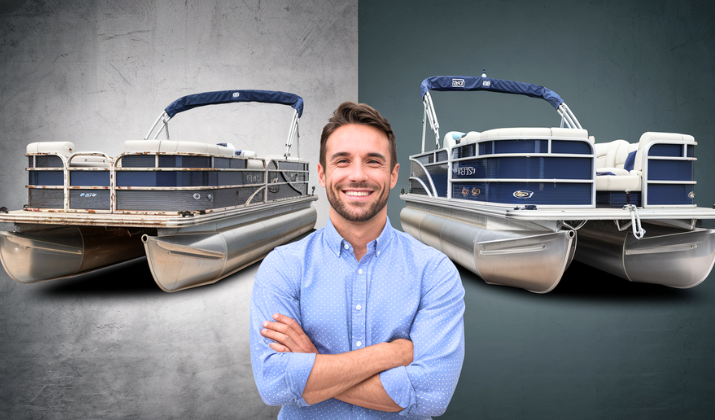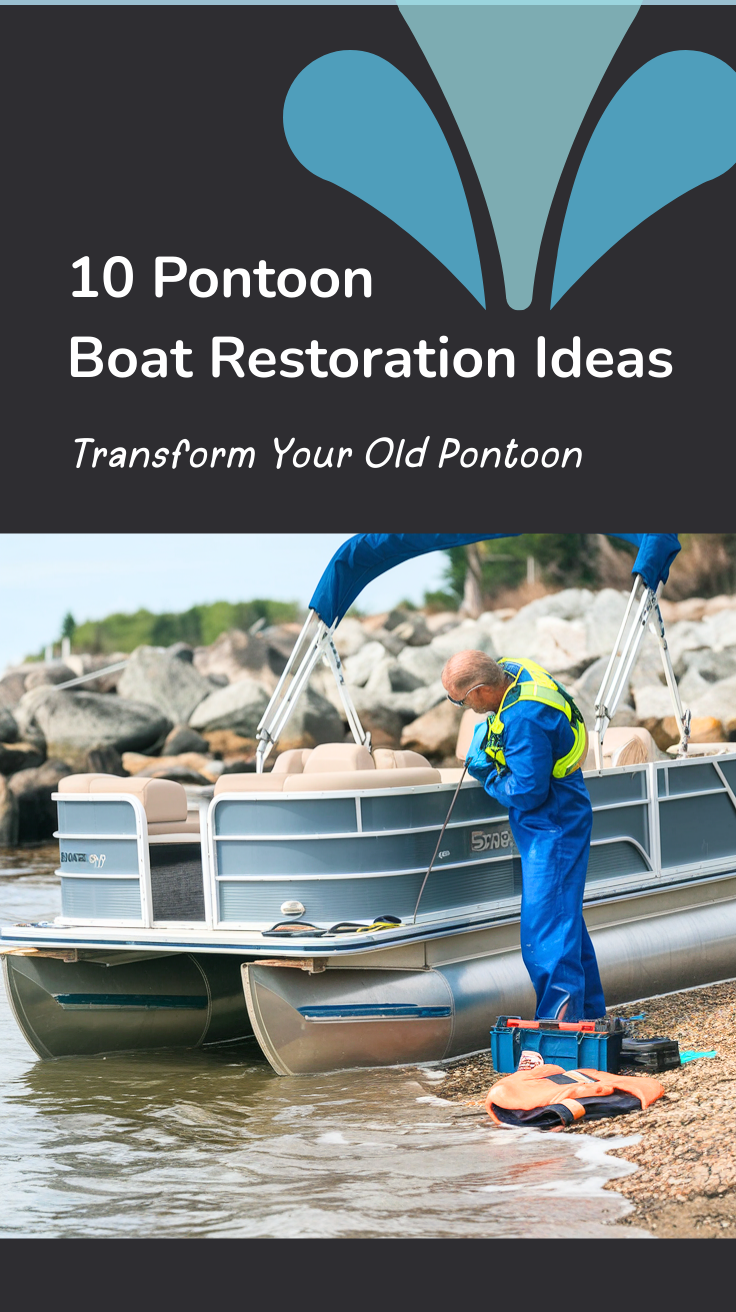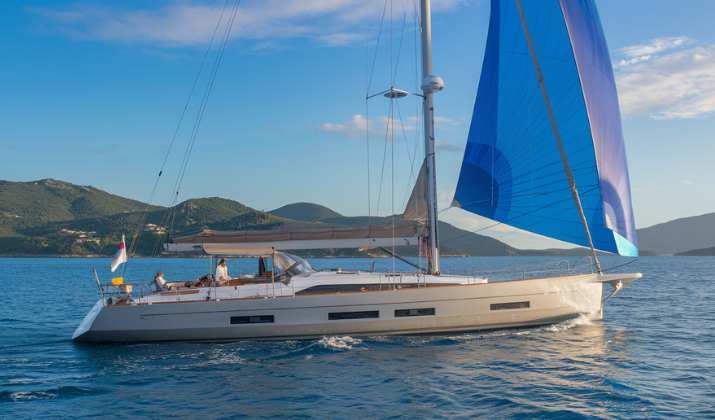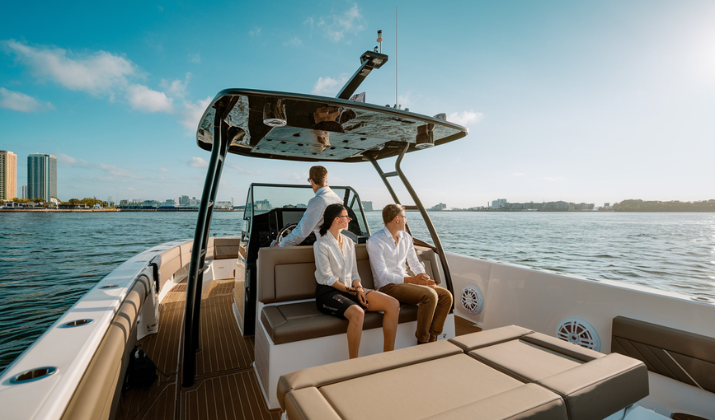There’s something magical about bringing a tired, weathered pontoon boat back to life.
If you’ve inherited a family vessel that’s seen better days or discovered a diamond in the rough at a marina sale, restoring it can be one of the most rewarding marine projects you’ll ever undertake.
Unlike other boat types that require extensive fiberglass work or complex hull repairs, pontoons offer a relatively straightforward restoration canvas that allows both novice and experienced boat enthusiasts to create something truly spectacular.
The beauty of pontoon restoration lies not just in the mechanical satisfaction of renewal, but in the opportunity to customize your floating retreat to match your exact vision of the perfect watercraft.
In this post, we will explore some great ideas to transform your pontoon boat that will infuse fresh lease of energy to your vassel adding fun and colors to your marine life.
Let’s begin.
Also Read: Must-Have Safety Gear For Pontoon Boats
1. Complete Deck Refinishing and Upgrade
The deck is the heart of any pontoon boat, and a complete refinishing can dramatically transform both the appearance and functionality of your vessel.
Start by thoroughly cleaning the existing deck surface, removing all furniture, hardware, and any old carpeting or vinyl flooring.
If you’re working with a traditional plywood deck, inspect it carefully for soft spots, rot, or delamination that may require replacement sections.
Consider upgrading to marine-grade aluminum decking, which offers superior durability and requires minimal maintenance compared to wood alternatives.
For those maintaining a wood deck, apply a high-quality marine wood stain or paint system designed to withstand constant moisture exposure and UV rays.
The key to a professional-looking deck restoration lies in proper surface preparation, including sanding, cleaning, and priming before applying your chosen finish.
Don’t forget to seal all edges and fastener holes to prevent water intrusion that could compromise your restoration work over time.
Explore: Pontoon Boats Must-Have Accessories
2. Pontoon Tube Cleaning and Refurbishment
The pontoon tubes are the foundation of your boat’s buoyancy and performance, making their restoration absolutely critical to both safety and aesthetics.
Begin with a thorough pressure washing to remove years of accumulated algae, barnacles, and general marine growth.
For stubborn stains and oxidation, use specialized aluminum cleaners or a mixture of oxalic acid and water, always wearing proper protective equipment and working in well-ventilated areas.
Pay special attention to the waterline area where staining is typically most severe. After cleaning, inspect the tubes for any dents, scratches, or punctures that might affect performance or lead to future problems.
Small dents can often be worked out using specialized tools, while deeper scratches should be sanded smooth and treated with marine-grade aluminum primer and paint.
Consider applying a protective coating or wax specifically designed for aluminum to help prevent future oxidation and make cleaning easier.
The transformation from dull, stained tubes to gleaming aluminum cylinders will dramatically improve your boat’s overall appearance and can even enhance its resale value.
Explore: Most Expensive Pontoon Boats
3. Electrical System Overhaul
A comprehensive electrical system upgrade is essential for both safety and modern functionality in any pontoon restoration project.
Start by completely removing the old wiring harness and electrical components, taking careful notes or photos of the original configuration for reference.
Inspect all wire runs for corrosion, fraying, or inadequate gauge sizing that could create safety hazards or performance issues.
Install a new marine-grade wiring harness using tinned copper wire, which resists corrosion far better than standard automotive wire in the harsh marine environment.
Upgrade your electrical panel to include modern circuit breakers, USB charging ports, and adequate capacity for contemporary electronics like fish finders, GPS units, and entertainment systems.
Don’t overlook the importance of proper grounding throughout the system, as poor grounding is a leading cause of electrical problems in marine applications.
Consider installing LED lighting throughout the boat, which draws less power, generates less heat, and provides superior illumination compared to traditional incandescent bulbs.
Check Out: Best Luxury Pontoon Boats
4. Furniture Reupholstery and Replacement
The furniture on your pontoon boat sets the tone for comfort and style, making it a crucial element in any restoration project.
Begin by carefully removing all existing furniture and assessing the condition of the underlying frames and foam cushioning.
Often, the frames are in good condition and simply need cleaning and minor repairs, while the foam and vinyl coverings require complete replacement.
When selecting new marine upholstery materials, prioritize UV resistance, mildew resistance, and durability over pure aesthetics, as these factors will determine how long your restoration maintains its fresh appearance.
Consider upgrading to higher-density foam that provides better comfort and longevity, and don’t forget to include proper drainage grommets to prevent water accumulation within the cushions.
Modern marine vinyl comes in an incredible variety of colors and textures, allowing you to create a custom look that reflects your personal style while maintaining the practical benefits of marine-grade materials.
Professional upholstery work can be expensive, but many boat owners find that reupholstering furniture themselves is a rewarding aspect of the restoration process that allows for complete customization at a fraction of the cost.
Explore: Pontoon Boat Hacks For Beginners
5. Canopy and Bimini Top Restoration
A quality canopy or bimini top not only provides essential shade and weather protection but also serves as a major visual element that can define your boat’s character.
Start by carefully inspecting the existing frame for any bent, cracked, or corroded components that might compromise the structure’s integrity.
Stainless steel frames generally require only cleaning and possibly some hardware replacement, while aluminum frames may need more extensive attention to remove corrosion and restore their finish.
The fabric portion of your canopy system will likely need complete replacement, as marine fabrics deteriorate over time due to constant UV exposure and weather cycling.
When selecting new fabric, choose marine-grade materials like Sunbrella or similar high-quality options that offer superior UV resistance, water repellency, and color retention.
Consider upgrading to a larger canopy design that provides more coverage, or add side curtains for additional weather protection.
Proper installation is crucial for both appearance and longevity, so take time to ensure all hardware is properly tightened and that the fabric is tensioned correctly to prevent premature wear and water pooling.
Explore: Pontoon Boat Brands To Avoid
6. Engine and Mechanical Systems Upgrade
The propulsion system is the heart of your pontoon’s performance.
If you’re working with an older outboard motor, consider whether restoration or replacement makes more sense economically and practically.
For restoration, begin with a complete service including spark plugs, fuel system cleaning, carburetor rebuild or fuel injection service, and lower unit oil change.
Inspect the propeller for damage and consider upgrading to a more efficient design that better matches your boat’s weight and intended use.
Don’t overlook the steering system, which may need cable replacement, helm rebuilding, or hydraulic system service depending on your boat’s configuration.
Upgrade to modern engine controls and gauges that provide better information about engine performance and can help prevent costly damage due to overheating or other issues.
Consider adding modern conveniences like electric start, power trim and tilt, or even upgrading to a more powerful engine if your pontoon’s capacity allows.
Check Out: Best Boat Paint Ideas To Inspire
7. Sound System and Entertainment Installation
Modern pontoon boats serve as floating entertainment centers, making a quality sound system an essential component of any comprehensive restoration.
Plan your audio installation carefully, considering both the electrical requirements and the physical placement of components in the marine environment.
Marine-grade speakers, amplifiers, and head units are specifically designed to withstand moisture, salt air, and temperature extremes that would quickly destroy automotive audio equipment.
Consider a distributed speaker system that provides even sound coverage throughout the boat without overwhelming any single area.
Waterproof Bluetooth connectivity allows passengers to stream music directly from their devices, while traditional inputs accommodate various audio sources.
Don’t forget to include adequate storage and charging solutions for mobile devices, as these have become essential accessories for modern boating.
When planning your installation, consider future expansion possibilities and ensure your electrical system can handle the additional load.
Explore: Boat Maintenance Tips
8. Lighting System Modernization
Replace all existing lighting with modern LED systems that offer superior efficiency, longevity, and brightness compared to traditional incandescent bulbs.
Navigation lights are legally required and should be the first priority, ensuring they meet current Coast Guard specifications for your boat’s size and type.
Consider adding underwater lighting that creates a stunning visual effect while also attracting fish for nighttime fishing activities.
Deck lighting should provide adequate illumination for safe movement around the boat while creating a pleasant atmosphere for socializing.
RGB LED strips allow you to customize the color and intensity of your lighting to match any mood or occasion. S
olar-powered accent lighting can provide gentle illumination without drawing power from your boat’s electrical system, making them perfect for areas where running wires would be difficult.
When installing any lighting system, pay careful attention to waterproofing and use marine-grade connectors throughout to prevent corrosion and ensure long-term reliability.
Also Read: Boat Flooring Mistakes To Avoid
9. Storage Solutions and Organization
Effective storage is crucial for maintaining a clutter-free, functional pontoon boat that maximizes both comfort and usability.
Begin by identifying all the items you typically carry on board, from safety equipment and fishing gear to personal belongings and entertainment supplies.
Custom storage solutions work best because they can be tailored to your specific needs and the unique layout of your boat.
Consider under-seat storage compartments that keep items dry and secure while maintaining easy access.
Overhead storage nets or compartments can hold lightweight items without interfering with passenger comfort.
Dedicated storage for life jackets, safety equipment, and fishing gear ensures these essential items are always accessible but don’t clutter living spaces.
Waterproof storage containers protect sensitive items like electronics, documents, and spare clothing from moisture damage. Built-in cooler storage keeps beverages and food cold while integrating seamlessly with your boat’s design.
When designing storage solutions, consider both accessibility and weight distribution to maintain proper boat balance and performance.
Explore: Easy Boat Shed Ideas
10. Accessories and Finishing Touches
The final details and accessories you choose can elevate your pontoon restoration from functional to spectacular, creating a truly personalized watercraft that reflects your style and meets your specific needs.
Consider adding a swim platform or ladder system that makes water entry and exit safer and more convenient for all passengers.
Fishing enthusiasts might want to install rod holders, fish cleaning stations, or even a livewell system for serious angling adventures.
Comfort accessories like cup holders, table systems, and weather protection enhance the overall user experience. Modern technology accessories such as GPS chartplotters, fish finders, and VHF radios improve both safety and functionality.
Don’t overlook practical items like dock lines, fenders, and anchor systems that are essential for safe boat operation.
Custom graphics, boat names, and registration numbers should be professionally applied to ensure they look great and last for years.
Consider adding safety equipment beyond the legal minimums, such as additional life jackets, fire extinguishers, and first aid supplies.
Explore: Best LED Boat Deck Lights For Night-Time Boating
Conclusion
Restoring your pontoon shouldn’t be a burden.
It’s an opportunity to create a personalized watercraft that will provide years of enjoyment for you, your family, and friends.
The transformation from a tired, neglected vessel to a gleaming, functional boat is incredibly rewarding and often costs far less than purchasing a comparable new pontoon.
Each of these restoration ideas can be tackled individually or as part of a comprehensive renovation project, allowing you to work within your budget and timeline while steadily improving your boat’s condition and value.


















